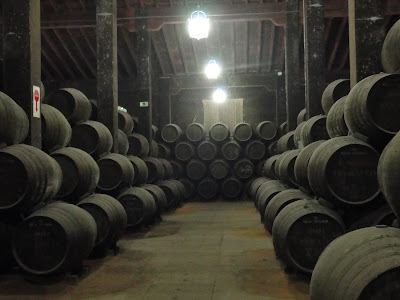Many of you may have visited a winery cellar, underground rooms with low ceilings, packed with stacks of barrels amidst the cool air. You might even have visited a wine cave, as I did when I was in Spain a few years ago. But on my recent visit to Spain, I beheld a radically different type of wine storage area, the sherry bodegas.
Richard Ford, the author of A Handbook for Travellers in Spain (published in 1845), thought that the bodegas resembled cathedrals. Many later writers would, understandedly, adopt that same simile as they do bear some resemblance to cathedrals. I visited nine bodegas and it was obvious to me why so many have made this comparison. But another writer, Rupert Croft-Cooke, had a different view, stating "But it might also be thought of as a great hive with thousands of cylindrical cells in which the living wine matures." (Sherry, p.115) That view also has some validity, and is in line with the feeling I received in some of the bodegas.
While wandering the aisles of the bodega above, I felt as if I were in an alien landscape, the humid air adding a haze to my view. The dark colors, thick cobwebs, and thick dust brought to mind great age and mystery. I could easily see this as some strange hive, where the bizarre creatures were but sleeping, waiting for something to awaken them. Shades of Ridley Scott's classic Alien film.
The term "bodegas" literally translates as "cellar" but is also used to refer to the "wine producer" and "winery." The bodegas, many constructed in the 19th century, are buildings of purpose, each element designed to benefit the ageing of the sherry, to assist the flourishing of the flor. There are very good reasons why such bodegas are almost never underground wine cellars.
Most bodegas are lofty, with their ceilings as high as forty feet or so, to help keep the bodegas cool. This adds to the feeling that you are in a cathedral. The ceilings are so high as it is believed that the volume of air in the bodegas should be about eighteen times as that of the volume of wine. Good air circulation is necessary for the flor and most underground wine cellar lack the proper circulation.
The outside walls of the bodegas are commonly whitewashed, to help reduce temperatures. For that same reason, bodegas may be built close to each other, to limit the amount of sun hitting the walls or vegetation may be grown between buildings, providing more shade. The walls of the buildings are at least about two feet thick, to support the high walls as well as to provide adequate insulation. The bricks in the walls, made from materials that help the cellar maintain high humidity, may be hollow too. In addition, the roofs are often insulated.
The floors of bodegas are commonly a mix of sand, lime and iron oxide. During very hot and dry weather, the floors may be sprayed with water two to three times a week. This water will soak into the floor and evaporate slowly, helping to keep the temperatures low and increase the humidity. As it was hot and dry when I visited Jerez, I saw some of the water spraying, and the bodegas were very humid. The humidity helps to reduces the rate of evaporation of the sherry in the barrels and promotes the growth of the flor.
Bodegas are commonly located either close to the sea or at high elevation, seeking to benefit from morning sea breezes and the poniente, the westerly, winds. Plus, they are constructed along a northeast-southwest axis, which help to give a minimum amount of direct sunlight. Windows are located high on the walls, and are usually rectangular to prevent sunlight from falling upon the botas. Plus, the windows commonly have blinds made of esparto grass, which keep out the sun but allow in the wind. The poniente is the most desirable, being cool and humid. But the levante, the easterly wind, is warm and dry, and much less desired.
Sherry botas are usually stacked no more than three or four high, as the added weight of a higher stack would damage the botas below. Once in place, barrels are rarely moved, and may remain in the same place for decades, and you can see the dust and spiderwebs verifying their age. The barrels are commonly painted matte black, allowing leaks to be more readily discerned. As these barrels are usually older, any repairs need to be conducted with old barrels, which are more expensive in the Jerez region than new barrels. This is the opposite of much of the rest of the wine industry.
The caps on the bungholes sit loosely, allowing some air into the bota, which is also very different from much of the rest of the wine industry which abhors allowing air to affect their wines in the barrel. Some of the bodegas have signed barrels, sometimes by visiting celebrities, from Winston Churchill to John Lennon, and other times by regular visitors, who thus gain a measure of immortality.
To educate visitors, most bodegas also have a display bota, with glass ends, to show the flor within the barrel.
My tour of the various bodegas was a fascinating and informative journey, showcasing an intriguing alternative to the usual wine cellars. If you get the chance, you should visit the sherry bodegas too.







No comments:
Post a Comment